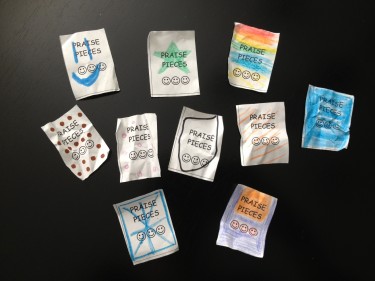 I silently dubbed this past summer the Summer From Hell. I feel a little obnoxious saying this because it wasn’t completely hellacious, but it was pretty darn close. My normally easy-going son was going through extreme mood shifts and his tantrums had become epic. I was left in tears, feeling completely defeated and fantasizing about the first day of school, still seven weeks off.
I silently dubbed this past summer the Summer From Hell. I feel a little obnoxious saying this because it wasn’t completely hellacious, but it was pretty darn close. My normally easy-going son was going through extreme mood shifts and his tantrums had become epic. I was left in tears, feeling completely defeated and fantasizing about the first day of school, still seven weeks off.
I knew praying for a speedy start to September wasn’t the answer to my problems. I reached out to my pediatrician, who you know I love, and he put me in touch with a social worker in his practice, Aimee Lataille. My son and I met with Aimee to understand the source his behavior and to get him back on track STAT.
Speaking with Aimee gave me the opportunity to reflect on the specific factors that were influencing my son’s negative behavior (spending an extra year in pre-school while his friends were moving on to kindergarten, sharing the limelight with his younger sister who was now coming in to her own). I realized that these things were really upsetting him, yet he didn’t have the processing skills to verbalize how he was feeling.
Aimee introduced the concept of ‘Praise Pieces.’ Essentially, every time my husband, babysitter or I saw my son doing a good thing, we marked his behavior by saying, “good job for doing such-and-such, that’s a Praise Piece.” Then we took a decorated slip of paper, aka a Praise Piece, and put it in a special container for him. When my son collected a certain amount of Praise Pieces, he could trade them in for different types of rewards.
Within a few days of using Praise Pieces, my son was starting to resemble his rational self. He loved the element of surprise that Praise Pieces brought. Would he get one for saying ‘thank you’ when he asked for a treat? Or maybe he would get one when he cleaned up his toys without complaining? It was like my son started to get addicted to the idea of behaving well. It was awesome.

I had the opportunity to interview Aimee for this article, so I’ll let her explain more.
Explain the Praise Piece system.
Positive behavioral plans, such as the “Praise Pieces” (which I learned parts of while working for Mclean Hospital), are designed to help children learn to change their behavior and develop more positive behaviors. Changing a child’s negative behavior is a process that requires consistency in providing positive reinforcement as well as consequences for bad behavior.
Why do kids misbehave?
Behaviors, whether positive or negative are a form of communication. For a behavioral plan to be effective for a child, it is important to understand what need your child is communicating when exhibiting negative behaviors.
A child who pushes his sister away or throws a toy at her during play time is expressing a need. He may have learned that doing this negative behavior typically results in separation from his sister, spending time in his room alone, having a parent remove the little sister, or the parent coming into the room and sitting and playing with them both.
How can a positive reinforcement plan like using Praise Pieces help correct negative behavior?
Using something like Praise Pieces acknowledges the times throughout your child’s day where he exhibits positive behaviors (sharing with his sister, making his bed without being asked) and results in small “rewards” after these praise moments add up.
Some of these rewards can be based on the information you have gathered by what his previous negative behaviors have communicated. For instance, if your child has expressed frustration that he always has to play with his little sister and does not have much alone time, then after collecting a certain number of Praise Pieces he can trade them in for 20 minutes of individual play one morning. It is important to note that these rewards do not have to be toys or anything of monetary value.
If a parent chooses to try out a plan like this, does that mean she shouldn’t use time-outs or take privileges away?
Even if you choose to use this type of plan, it does not mean your child should not have any consequences for his negative behavior. However, the consequences you choose, whether a time out or taking something away should be consistent and age appropriate.
Not a cure-all
While the Praise Piece system was hugely helpful, it was just a part of a bigger plan to help my son feel better about himself so he wouldn’t act out.
Now I’m more tuned in to his needs. I’m teaching him to ask for help when he feels overwhelmed. When little sister wants to wreck his Legos, instead of blowing a gasket, he now knows to take a deep breath and find his dad or me to redirect his little sister. We’ve also had many conversations about it being okay to be in pre-school for another year.
Interestingly, as the weeks progressed, my son became less interested in the reward part of the Praise Pieces. He just loved hearing that his dad and I were proud of him for making good choices and behaving.
I continue to be so grateful for Aimee’s help. Thanks to her, I truly enjoyed the final weeks of summer before my son returned to school in September.

If you have strategies that have helped when your child has gone through a tough time, please consider sharing them below. Let’s help each other out and build an arsenal of tools we can use when they going gets tough.
Jean Stehle (steel) is a writer and a teacher. She lives in Newton with her husband and two young children. More at: www.facebook.com/jeanstehle.writer and @jeanstehle



